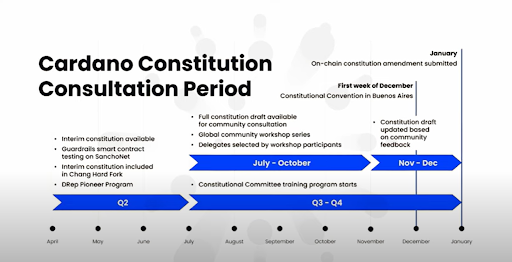Introduction
As an open-source, third-generation blockchain, it is crucial to ensure that Cardano is sustainable and grows in a decentralized and organic manner. Decentralized governance and decision-making are vital to give everyone a voice and control over the protocol’s future development. The community is central to Cardano’s identity, and Cardano’s governance model reflects this by demonstrating the achievability of liquid and representative democracy. Through individual participation and immutable vote recording, ADA holders can decide treasury fund distribution and the platform’s future development.
As a community, how can we work together to outline policies and guidelines for Cardano’s future development and ensure that everyone has a voice?
The Role of the Constitution
Traditionally, constitutions are collections of rule sets that determine how laws are enacted, administered, and adjudicated in a given society. A constitution is vital to Cardano’s community-led ecosystem to ensure:
- fair participation
- protection
- foundation to meet current and future demands within a maturing ecosystem.
The final constitution will be ratified by ADA holders using the on-chain voting features of Voltaire. Relevant provisions of the constitution will be enforced on-chain by the Constitutional Committee. The committee must vote on-chain along with ADA holders, but rather than providing their opinion on the merits of a proposal, they will signify its constitutionality. Where feasible, parts of the constitution will be automatically enforced using a smart contract associated with the constitution on-chain, thus reducing reliance on the Constitutional Committee.
Governance is not optional.
As Charles Hoskinson put it: “No matter who you are or what you do, when you create something that other people use, the first question is how do we upgrade, maintain, and change it to meet our needs?”
The Cardano Improvement Proposal (CIP) 1694, was written by the community to discuss the future of on-chain governance for Cardano and ensure the sustainability of the platform. Named after the year of birth of [the Enlightenment thinker] Voltaire, the CIP aims to give everyone a voice and say in the direction of Cardano. It seeks to advance the current governance system, ensuring every ADA holder has a voice in Cardano’s governance. It outlines a voting framework to decide on: updates to the protocol new standards for improvements on-chain funding decisions governance of Cardano native tokens. The proposal outlines a tricameral* model, consisting of Stake Pool Operators, Delegate Representatives, and a Constitutional Committee, each with distinct responsibilities and roles.
- tricameral: adjective; (of a legislative body) having three chambers. eg. “the tricameral parliamentary system”
Governance Roadmap
Cardano governance has a clear roadmap to bring the community through this whole process. The stages of the Cardano governance roadmap, particularly under CIP 1694, reflect a structured approach to evolving Cardano’s governance model into a decentralized and community-driven system. This roadmap is designed to transition governance gradually, allowing for ample community feedback and refinement.
Chang Upgrade
The Cardano Chang Upgrade, which is part of the blockchain’s transition to the Voltaire Era, involves two major stages.
Stage One, known as “Change Upgrade number one”, involves deploying new governance features on Cardano. This marks the beginning of the technical bootstrapping phase described in CIP 1694, setting the stage for decentralized voting and governance actions. This first stage is scheduled to begin in the summer of 2024. Its purpose is to enable initial governance features and lay the groundwork for Conway-era functionality. During this time, DReps will be able to register, and ADA holders can delegate their voting power. Plutus P3 will also be introduces new governance features.
An interim constitution will be established with safeguards supported by a technical guardrail script. An interim Constitutional Committee will help oversee and facilitate decision-making during the interim period before the full constitution is ratified. The bootstrap period will also be used to form the group of DReps. Limited governance actions will be supported, including parameter changes, hard forks, and info actions. During the interim period, only SPOs and the Constitutional Committee will be able to vote on governance actions, including possible protocol parameter changes. The goal of the first stage is to ensure security and continuity during the governance bootstrapping phase, allowing DReps to register and campaign for delegation while developing and ratifying a final constitution in 2024.
The second stage, “Chang Upgrade Number Two,” takes the system out of the technical bootstrapping phase. This step unlocks the final features of on-chain governance, such as the participation of delegate representatives and treasury withdrawals. This enables the Cardano community to propose and fund new projects to ensure the ecosystem’s sustainability and evolution. The second stage, which emphasizes decentralized governance, will be initiated by the community after the bootstrap period is complete. All governance entities, including DReps, SPOs, and the Constitutional Committee, can vote on governance actions during this stage. The conclusion of this stage will allow for treasury withdrawals. These steps are designed to enhance Cardano’s governance mechanisms, making the platform more community-driven and self-sustaining.
Ratifying the Constitution
The ratification of the Cardano Constitution as part of the governance model proposed in CIP 1694 involves several crucial steps to transition Cardano to a decentralized on-chain governance system. With an interim constitution in place to ensure the safety of the chain through this transition period, 2024 is all about community consultation. A series of global workshops will take place, gathering input from across the Cardano ecosystem throughout the latter part of the year, all leading up to the Constitutional Convention in Buenos Aires in December and the eventual ratification of a final constitution by the community in early 2025.

Smart Contracts for Smart Governance
The initial set of technical guardrails within the Cardano governance model is defined by the community through the Cardano Parameter Committee. Once the guardrails are defined, they can be codified into a smart contract to automate their enforcement on the blockchain, ensuring all actions adhere to the community-agreed standards.
Guardrails will ensure that proposals for parameter changes and treasury withdrawals are evaluated against these preset rules. If a proposal violates these rules, it is automatically rejected by the blockchain, preventing unconstitutional actions from being executed.
The Constitutional Committee
The Constitutional Committee comprises a set of individuals or entities responsible for overseeing the governance actions defined in CIP 1694 to ensure that the constitution is respected. Once CIP 1694 is implemented with the Chang upgrade, the Constitutional Committee will be a governing body of the new on-chain governance features of Cardano. It will have the power to evaluate the constitutionality of a governance action submitted on-chain and will be responsible for ensuring that any unconstitutional on-chain governance actions are rejected and will therefore be integral to Cardano’s operations.
This committee operates under two states: a normal state of confidence and a state of no confidence. In the state of no confidence, the committee cannot participate in governance actions and must be replaced to proceed with any governance decisions.
The process for registering as a Constitutional Committee member involves community nomination and elections where candidates demonstrate their understanding and commitment to Cardano’s governance principles. Specific details on the eligibility criteria, nomination process, and election mechanisms will be outlined in the governance documentation and may evolve as the community refines its governance structures.
Members of the committee are expected to commit to a term potentially, spanning years, reflecting the significant responsibility and continuity required in this role. It is not a short-term commitment, but rather a substantial engagement, depending on the evolving needs of the governance framework.
The Constitutional Committee acts as a decision-making group, reviewing proposed changes and actions to ensure they align with Cardano’s foundational principles. This involves a commitment to timely monitoring of governance actions, allowing the Committee to provide informed and timely votes on key issues.
The Cardano Constitution
The Cardano Constitution is a foundational document that outlines the guiding principles and values for governance on the Cardano blockchain. It sets the framework for decision-making processes, defines the roles and responsibilities of various governance bodies, and establishes the rules and procedures for making changes within the network. This constitution is intended to ensure that Cardano’s development and operations remain aligned with the community’s interests and that governance remains transparent, inclusive, and effective. As Cardano evolves, the constitution may also be amended to reflect new insights and requirements.
Interpreting the Cardano Constitution involves a detailed analysis of its clauses, akin to how legal documents are interpreted in judicial systems. Each clause in the constitution needs to be examined for its literal meaning, intent, and the implications it has on governance practices. For instance, a clause might specify the conditions under which changes to network protocols can be proposed, detailing procedural requirements and stakeholder responsibilities.
When drafting decisions on the constitutionality of governance actions, it is essential to provide clear reasoning for the vote, explaining why it is necessary and how it aligns with the constitution. This helps build a strong foundation for the governance model and legitimacy for the constitutional process. As the network evolves,precedent plays a crucial role in interpreting a constitution. It involves using previous decisions or established practices as benchmarks for interpreting similar new situations. By referring to past interpretations or applications of the clauses, the community can ensure consistency and fairness in governance actions, reducing ambiguity and potential conflicts.
Tools and Resources
Constitutional Committee members will have access to various tools on the Cardano blockchain designed to facilitate their governance roles effectively. These tools will include voting systems integrated directly into the blockchain, allowing for secure and transparent decision-making. The Constitutional Committee portal is a tool to host the Cardano Constitution and allow anyone to get familiar with it and follow its evolution over time. It will also serve as the single point of truth for the Constitutional Committee members to see how members voted on a specific governance action, including their rationale. For members of the Constitutional Committee, it serves as a portal to add reasoning to their votes and prepare it as an off-chain resource to be attached to on-chain governance actions. Additionally, analytics and monitoring tools will be provided to track governing proposals and their outcomes, ensuring that committee members can oversee adherence to the constitution effectively. These tools will be crucial for maintaining the integrity and functionality of the governance process within the Cardano ecosystem.



Aucun commentaire pour le moment...